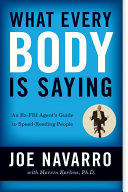

Nonverbal communication is a crucial aspect of human interaction. It encompasses body language, facial expressions, posture, and gestures, all of which convey messages beyond words. This book emphasizes the importance of recognizing and interpreting these nonverbal cues to gain insight into people's thoughts and feelings. The author, Joe Navarro, a former FBI agent, draws on his extensive experience in observing human behavior to explain how nonverbal signals can reveal true intentions. For instance, crossed arms may indicate defensiveness, while open palms can signify honesty and openness. By learning to read these signals, individuals can improve their interpersonal skills, enhance their ability to connect with others, and navigate social situations more effectively.
Continue readingContext is key when interpreting nonverbal communication. The same gesture or expression can have different meanings depending on the situation and the individuals involved. Navarro stresses that one must consider the environment, cultural background, and the specific relationship between the people communicating. For example, a smile may indicate friendliness in one context but could be a sign of discomfort or sarcasm in another. This idea highlights the complexity of human interactions and the necessity of being observant and adaptable. It encourages readers to look beyond surface-level interpretations and to consider the broader circumstances that shape communication.
Continue readingMicroexpressions are brief, involuntary facial expressions that reveal genuine emotions. These fleeting expressions can last only a fraction of a second and often occur when a person is trying to conceal their feelings. Navarro explains that being able to recognize microexpressions can provide critical insights into a person's true emotions, even when they are verbally denying them. For example, a quick flash of anger on someone's face can indicate underlying frustration, despite their calm demeanor. Understanding microexpressions can be particularly useful in high-stakes situations, such as negotiations or interviews, where understanding the other party's true feelings can lead to better outcomes.
Continue readingNavarro emphasizes that no single nonverbal cue should be interpreted in isolation. Instead, it is essential to look for clusters of signals that work together to convey a message. For example, if someone is speaking and their arms are crossed while they avoid eye contact, these signals collectively suggest discomfort or defensiveness. By observing multiple cues, individuals can gain a more accurate understanding of what someone is communicating. This idea encourages readers to develop a holistic approach to interpreting body language, rather than relying on isolated signals that may be misleading.
Continue readingBody language significantly influences how others perceive us. Navarro discusses how our nonverbal behavior can affect the impressions we make, our credibility, and our ability to persuade. For instance, maintaining an open posture and making appropriate eye contact can enhance one's authority and likability. Conversely, closed-off body language can lead to misunderstandings and negative perceptions. This idea highlights the importance of self-awareness and the need to align our body language with our verbal messages to communicate effectively. It serves as a reminder that we are constantly sending signals to those around us, whether we intend to or not.
Continue readingThe book provides practical strategies for applying nonverbal communication skills in everyday life. Navarro offers tips for improving one's own body language, such as being mindful of posture, gestures, and facial expressions. Additionally, he shares techniques for reading others' body language, which can enhance personal and professional relationships. By practicing these skills, individuals can become more adept at navigating social interactions, resolving conflicts, and building rapport. This idea emphasizes that nonverbal communication is not just an abstract concept but a practical tool that can be cultivated and applied in various contexts.
Continue readingFinally, Navarro touches on the ethical considerations surrounding nonverbal communication. While understanding body language can empower individuals in their interactions, it is essential to use this knowledge responsibly. Misinterpreting or manipulating nonverbal signals can lead to deception and mistrust. The book encourages readers to approach nonverbal communication with integrity, using their skills to foster genuine connections rather than to exploit or manipulate others. This idea serves as a reminder that the ultimate goal of understanding body language should be to enhance communication and relationships, rather than to gain an unfair advantage.
Continue reading